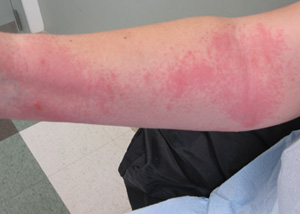Drexel Researchers Discover Underlying Cause of Eczema
February 19, 2014

An estimated 30 million Americans suffer from eczema – the term for a group of medical conditions that cause the skin to become inflamed or irritated. The most common type of eczema is known as atopic dermatitis (AD). Now, researchers at Drexel University College of Medicine have shown for the first time what actually causes the itchy skin condition.
As reported in the online edition of JAMA Dermatology, the researchers found that the staphylococcal bacteria that are normally found on the skin surface produce a slime-like substance called biofilm, which blocks the sweat ducts. That blockage activates molecules in the immune system known to create itching and inflammation.

The research was led by Herbert B. Allen, MD, professor and chair of the Department of Dermatology at Drexel University College of Medicine. "The dermatology community has known that this staph germ was present in eczema," said Allen. "But what we've been able to do in our research is to determine what the staph is doing to cause 'the itch that rashes.'"
Allen and his colleagues studied routine swabs from lesional and nonlesional skin from 40 patients with AD. All AD-affected samples contained multi-drug resistant staphylococci, which were all positive for biofilm.
"We know that eczema is worse when it involves sweating," explained Allen. "So the staphylococci are exposed to the salt water from the sweat ducts and produce the duct-occluding biofilm." Allen continues that that biofilm blockage of sweat ducts activates the immune system's first responders, which causes the itchy, red rash characteristic of AD.
Eczema, explains Allen, has both a genetic component and an environmental component. "This is the environmental hit," he says. "But patients can improve their genetic defects and prevent this disease by treating the skin kindly – using less soap, less hot water, less bathing and scrubbing, and more moisturizing." When necessary, antibacterial compounds, such as bleach baths, can also be an effective therapeutic approach.
Allen is now looking at diseases that have eczema as part of their presentation, including seborrheic dermatitis, granular parakeratosis, prickly heat, and tinea pedis (athlete's foot) to see if occluded ducts also play a role.
Back to Top